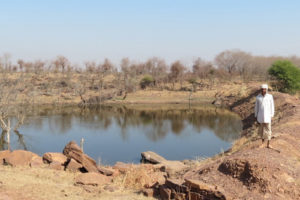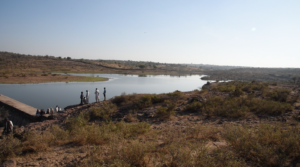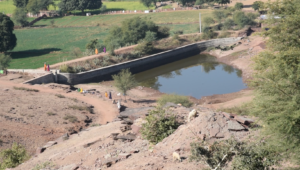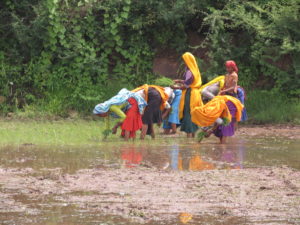 Gram Gaurav has undertaken a massive mission for augmenting the water resources in the Dang region. To beat the high level of water scarcity and poor agricultural productivity, Gram Gaurav Sansthan supports the local households in the construction of various irrigation structures. Two types are listed below:
Gram Gaurav has undertaken a massive mission for augmenting the water resources in the Dang region. To beat the high level of water scarcity and poor agricultural productivity, Gram Gaurav Sansthan supports the local households in the construction of various irrigation structures. Two types are listed below:
Pokhar is a conventional water harvesting structure built by constructing earthen bunds upstream in the nallas, which act as waterways during monsoons and remain dry for the rest of the year. This structure provides water primarily for irrigation and livestock. Pokhars and Pagaras, often complement each other such that the water collected in the Pokhars is used to irrigate the land created by the Pagaras.
 Taal is a pond that is created by deepening the existing depression downstream of the nallah with the highest potential for water collection. Ideally, the nallah should be situated on community land and lie close to the beneficiary village. These Taals have been a major success as they have not only addressed drinking water issues for the local population but have also derived popularity due to their low cost.
Taal is a pond that is created by deepening the existing depression downstream of the nallah with the highest potential for water collection. Ideally, the nallah should be situated on community land and lie close to the beneficiary village. These Taals have been a major success as they have not only addressed drinking water issues for the local population but have also derived popularity due to their low cost.
Stories that Inspire
The padded pond
 Birka, a village situated in middle of the forest in Karauli district (Rajasthan), is home to 50 families from the backward community who practice farming and animal husbandry. The barren land and unsteady rainfall have made livelihood impossible in the village. The villagers of Birka reached out to Gram Gaurav in order to gain some benefits from the Sansthan’s water harvesting techniques. Upon visiting Birka, the Gram Gaurav team realized that agriculture would flourish if harvested rain water is made available by building. a pokhar. With contribution from the villagers, Gram Gaurav built a pokhar in 2013-14. The first rain itself filled the pokhar with water, resulting in an increased food security for six months. Bachchu Singh Gurjar, the beneficiary, intimated that 42 years ago when “I was only eight years old, my mother died. My father had to work in the mines nearby and raised us four brothers with great hardship. By the age of 15, I too started travelling to a neighboring village to work in the mines in order to ensure food security for the family. After a year, my younger brother also started working along with me. Our lands were barren due to lack of water supply; hence we were totally dependent on the mines for subsistence. After 15 years of hard-hitting work in those subterranean mines, we realized that we have developed a chronic occupational disease named Silicosis and could not continue working there. With no arable land of our own we started working in other farms as hired labour. At the age of 30, I had no savings, no agriculture worthy land, no food security and as living with a life-threatening disease.” The story of other villagers was not different. “It was then that the Gram Gaurav Sansthan came to our aid and built this Pokhar. Since then we have been able to develop four bighas of land, which provide enough wheat to feed our children for the whole year,” he added.
Birka, a village situated in middle of the forest in Karauli district (Rajasthan), is home to 50 families from the backward community who practice farming and animal husbandry. The barren land and unsteady rainfall have made livelihood impossible in the village. The villagers of Birka reached out to Gram Gaurav in order to gain some benefits from the Sansthan’s water harvesting techniques. Upon visiting Birka, the Gram Gaurav team realized that agriculture would flourish if harvested rain water is made available by building. a pokhar. With contribution from the villagers, Gram Gaurav built a pokhar in 2013-14. The first rain itself filled the pokhar with water, resulting in an increased food security for six months. Bachchu Singh Gurjar, the beneficiary, intimated that 42 years ago when “I was only eight years old, my mother died. My father had to work in the mines nearby and raised us four brothers with great hardship. By the age of 15, I too started travelling to a neighboring village to work in the mines in order to ensure food security for the family. After a year, my younger brother also started working along with me. Our lands were barren due to lack of water supply; hence we were totally dependent on the mines for subsistence. After 15 years of hard-hitting work in those subterranean mines, we realized that we have developed a chronic occupational disease named Silicosis and could not continue working there. With no arable land of our own we started working in other farms as hired labour. At the age of 30, I had no savings, no agriculture worthy land, no food security and as living with a life-threatening disease.” The story of other villagers was not different. “It was then that the Gram Gaurav Sansthan came to our aid and built this Pokhar. Since then we have been able to develop four bighas of land, which provide enough wheat to feed our children for the whole year,” he added.
The story of Maharajpura
 Dang region in the Karauli District of Rajasthan alludes to its backwardness. The enormous and eroding valleys’ of Aravali has also offered a safe habitat to the bandits. The region is long deprived of basic amenities such as roads, electricity, schools or health. The economy of this region is predominantly agricultural, which suffers from the acute scarcity of water. No efforts were made to preserve rain water and other degrading natural resources until Gram Gaurav Sansthan in partnership with Rajiv Gandhi Foundation took constructive measures for its conversation. With its proactive efforts, it succeeded in building more than 500 water preservation structures in several villages of the Dang region. The Foundation has helped setup the ‘Gram Gaurav Sansthan’- a self-reliant organization to carry forward its work in natural resource management with the inclusion of village community and panchayats.
Dang region in the Karauli District of Rajasthan alludes to its backwardness. The enormous and eroding valleys’ of Aravali has also offered a safe habitat to the bandits. The region is long deprived of basic amenities such as roads, electricity, schools or health. The economy of this region is predominantly agricultural, which suffers from the acute scarcity of water. No efforts were made to preserve rain water and other degrading natural resources until Gram Gaurav Sansthan in partnership with Rajiv Gandhi Foundation took constructive measures for its conversation. With its proactive efforts, it succeeded in building more than 500 water preservation structures in several villages of the Dang region. The Foundation has helped setup the ‘Gram Gaurav Sansthan’- a self-reliant organization to carry forward its work in natural resource management with the inclusion of village community and panchayats.
Maharajpura, an enormously backward village, is situated at 300 meters from the foothills of the Aravali Mountains in the Sherni Region. The village is home to 100 families out of which 98 belong to the other backward classes and 2 schedule tribes.
To encourage the consequential practice of rainwater harvesting and to advance the participation of the affected villages, an awareness rally and a meeting were conducted. It was disturbing to witness the catastrophic condition of the village. Moving forward, a mutual consensus was developed between the team and the village community who was convinced to build a water harvesting structure. The Gram Gaurav Sansthan team, with support from the villagers, made eloquent efforts to identify a suitable location and mobilization of resources. The construction was commenced with support from the local community who also garnered small funds and made contributions in the construction cost. These motivated group of villagers also sought approvals from local authorities. Therefore, in 3 months a reservoir of rain water was created which had the potential to supply sufficient water for irrigation. In 2012, the year this structure was built, a total of 712 acres of land was utilized for farming and in no time the farms flourished with a fresh harvest. Further next year, the village produced a total of 1840 quintal mustard, 3378.80 quintal wheat and 20 quintals of barley. This year, the land sown was expanded from 712 to 825 acres as the villagers levelled up the decayed 113 acres which significantly increased the production. The villagers invest time to preserve the harvested water reservoir and are living a more satisfactory life.